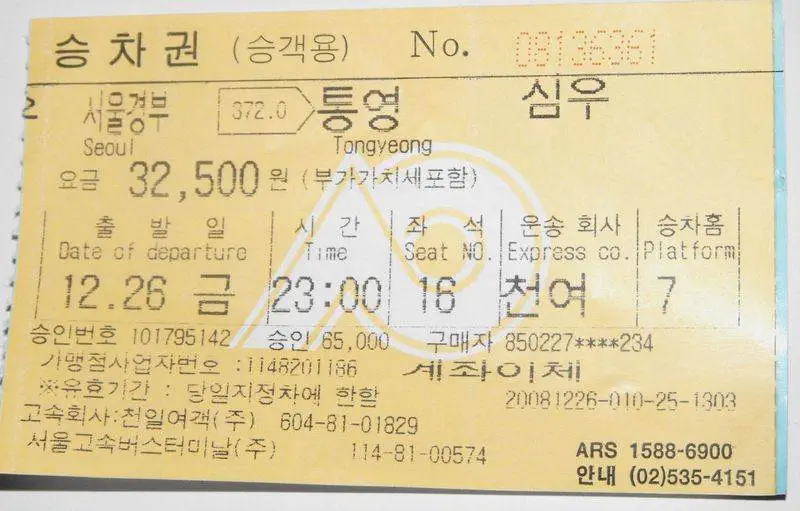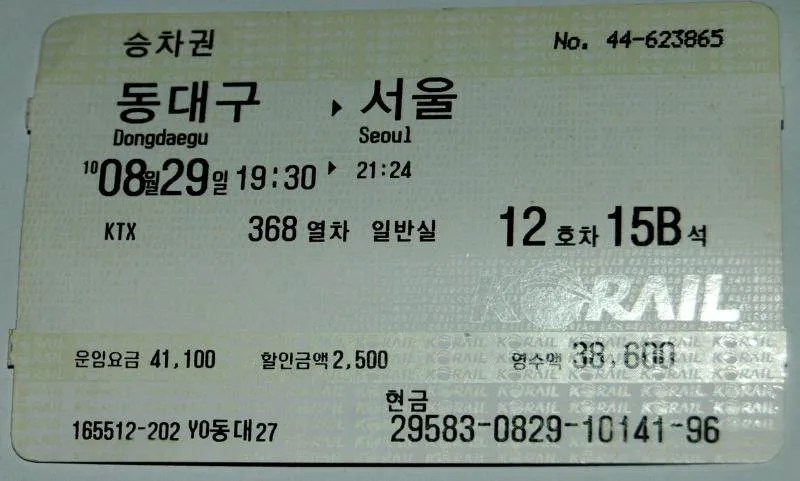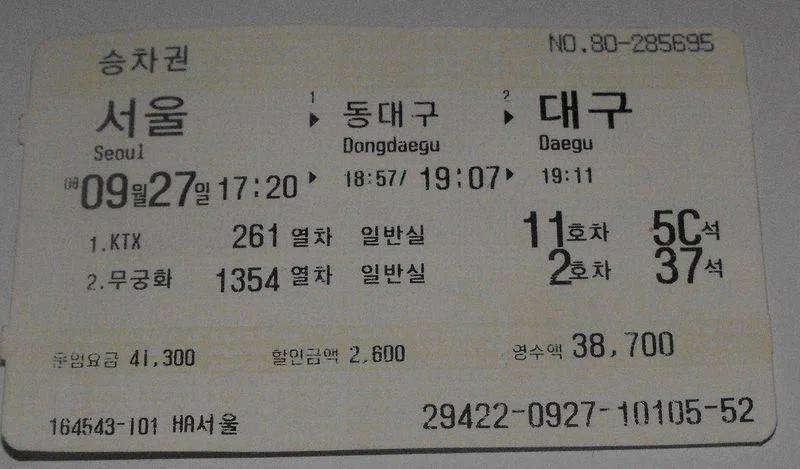The good news about Korean bus and train tickets is that they’re fairly intuitive and easy to figure out once you’ve seen a few of them and can read Korean. The bad news: there are many different kinds of tickets, each just a bit different. If you can figure out the vocabulary, however, the style of the ticket doesn’t matter. Let’s take a look at a couple express bus (고속 버스 – go-sok beo-seu) tickets:


At the top, start with your departure place on the left and the arrival place to its right.
You can read the English translations for yourself:
- 출발인 (chul-bal-il): date of departure
- 시간 (si-gan): time of departure
- 좌석 (jwa-seok): seat number
- 운송 회사 (un-song hwi-sa): the name of the bus company – in the first ticket’s case, 천여 (Cheon-yeo); in the second ticket’s case, 금호 (Geum-ho). Unless you ask for a specific company, you’ll typically get a ticket for the departure time you choose. I’ve yet to notice a significant difference in the quality of buses, so any company will do.
- 승차홈 (seung-cha-hom): platform – which numbered door to look for the bus. Beware: it’s not always listed on the ticket! Be sure to ask if the terminal’s signs aren’t clear.
Two important words to know in the upper-right corner: 심우 (sim-u): a ‘midnight’ bus; the classification of the last bus(es) of the night. You’ll pay a premium above the 우등 (u-deung), or ‘luxury’ bus, though.
Also of note: On each ticket, Seoul is referred to as 서울경부 (Seo-ul Gyeong-bu), which refers to the Gyeongbu Expressway. It’s the major expressway that connects Seoul to Busan.Since there are multiple bus terminals in Seoul, you might also see them referred to as 강남 (Gang-nam) or 경부 (Gyeong-bu) for the Express Bus Terminal, or 남부 for the Nambu Bus Terminal. The 강변 (Gang-byeon) Bus Terminal is also called the 동서울 (Dong, or east, Seoul) terminal. The 신촌 (Sinchon) Bus Terminal and 상봉 (Sangbong) Bus Terminal are smaller and less likely to confuse you.
There’s plenty of other Korean text on the tickets, but for the most part it’s easily ignored.
Time for the trains!


A little less help here. Sure, the departure and destination points are in English, but the rest needs some explaining. Note that on the second train ticket, 동대구 (Dong-dae-gu) is a transfer station. Directly below the places are the scheduled times of departure and arrival. You may already know 월 (wol) and 일 (il) as month and day, respectively.
Vocabulary:
- KTX = Korea Train eXpress. Korea’s first-class trains capable of 300 km/h.
- 새마을 (sae-ma-eul) are Korea’s second-class trains – a nice compromise between speed and stops.
- 무궁화 (mu-gung-hwa) = Korea’s third-class trains; they make more stops but are cheaper.
- 열차 (yeol-cha) = train
- 일반실 (il-ban-sil) = il-ban means normal, while sil means room. Put them together and it makes ‘normal class’ as opposed to ‘first class’.
- 호차 (ho-cha) = car number
- 석 (seok) = seat
- 운임요금 (un-im-yo-geum) = Base ticket price in Korean won
- 한일금액 (han-il-geum-aek) = Discount amount (getting tickets in advance or ordering tickets from a ticketing machine will get you an automatic discount)
- 영수액 (Yeong-su-aek) = Amount you paid for the ticket – base ticket minus the discount (do the math in your head)



Fantastic article! I had to RT this!
Am there with QiRanger- am RTing. I never actually tried reading the hangul parts. For me, reading transportation tix has become so intuitive and visual– I appreciate that Korea is good about making the important facts leap out on their tix. Having had this when I first arrived though would've been nice & I'm cutting and pasting some of these words into my vocab!
Really useful post Chris! There have been a few times I've ended up sitting in the wrong seat only to be prodded out of it as soon as I fell asleep. All I need to do now is remember to take my reading glasses when I travel.